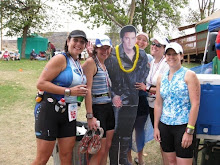by Russ Cox
from EnduranceCorner.com
"You've put on some weight."
Unfortunately this blunt assessment from a member of my masters squad is true. I had to agree and excuse myself on the grounds of not training so much in winter. Catching up with friends later that week there were shocked reactions to my admission. I hadn't trained?
Absolutely. I did enough to keep me going; I needed time off, a mental and physical break was overdue. When it comes to fitness I've reached a long time low and when it comes to weight... let's say it's a touch higher than normal.
Fitness and body composition are important to an athlete. I’d normally be panicking about now. Desperate to correct the situation I'd eat as little as possible and train every available hour. My fear of losing fitness has driven me through hard training and minimal recovery. But letting fitness go this winter has been good.
It's easy to undervalue the mental benefits of properly recovering. I stopped stressing. I coped with winter by putting training on the back-burner. Enough to tick over, no more. As signs of spring appear my motivation is returning. I want to train again and I have the conditions for it.
Hibernating wasn't without its costs. I can feel the effects: training is harder and recovery slower. But it takes a lot to lose the cumulative gains from years of endurance training. I've seen it at the swim squad. Over a month I've moved from the back to the front of my lane. A few seconds off last year's best that I'm sure I'll soon reclaim. Lightening the load over winter was a small step back; regaining motivation is a big step forward.
Returning to training after a break puts me in a rare situation. The mind is willing, but the body lags behind. It's reminiscent of my beginnings in endurance sport. The desire to push myself, but lacking the resilience to handle the load. Injuries were all to common. I don’t want to relive those days. Training dictated by my state of health more than a plan.
Instead I've revisited some of the training habits that helped me through:
Preventative maintenance
Muscles unfamiliar with the training regime tighten and form knots in response. My long neglected foam roller is back in action, an essential part of the day. Were it not for the regular, painful sessions on it I'd soon run myself into the ground. When DIY isn't good enough: a regular massage appointment gets deeper than I can reach.
Prevent rather than treat injuries and you'll be back training sooner.
Steady Effort
Last year I learnt to work hard on the bike. But last week pushing the pace on the bike had me limping home with a cramp. Any plans to run later had vanished. Repeating the route a few days later I kept the pace steady. I was home a little later, but managed that run. Steady is no problem; intensity is another story. Until I can handle the load I shouldn't seek to increase it.
Build back into training. Don't try to smash out last season’s best efforts.
Technique
This is the perfect time to address issues with technique. I want to avoid injuries and lack the fitness to go hard. I watch my form closely. Are my hips even on the run? Am I maintaining a high elbow in the pool? I played with cadence on the bike, breaking out of my grinding habit for a while. These may not directly build fitness, but they help keep my progress injury free.
Put an emphasis on technique to help keep injury at bay. It’ll pay off in the long-term too.
Winter is a tough season for endurance athletes. We have to give up some of what we’ve worked so hard towards. Losing fitness and gaining a little weight isn't a disaster especially when it helps restore motivation. Don't underestimate the importance of being mentally refreshed.
Once you're ready to return take care. Think back to when you first started the sport and how hard it was. It takes time to prepare the body for endurance training. Adopting a few good habits to keep injury at bay will make see you back in action much sooner.
Subscribe to:
Post Comments (Atom)





















No comments:
Post a Comment